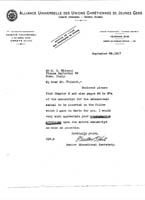Table of Contents
Appendix 8a
Educational Activities for War Prisoners
 J. Gustav White, an American WPA secretary, wrote this handbook, with the assistance of Paul Arni of the World's Alliance, for the
establishment and development of Association educational programs for prisoners of war in 1917. The International Committee in New
York despatched White, a fluent speaker of German and Russian, to Austria-Hungary to work with Russian POW's. When the Dual Monarchy broke off diplomatic relations with the United States on 8 April 1917, White and the other American WPA secretaries left for new YMCA
assignments. White ended up in Geneva, working with the World's Alliance of YMCA's to help neutral secretaries, which were replacing
the American Red Triangle workers in Germany and Austria-Hungary, take over War Prisoners' Aid operations. White developed this
handbook for WPA secretaries, based on his own experience, to assist a wide range of POW's deal with their educational needs. The goal
of the Association was not only help prisoners of war survive their incarceration, but to improve POWs during their captivity to
make them more productive citizens after the war. Education played a fundamental role in this broad strategy.1
J. Gustav White, an American WPA secretary, wrote this handbook, with the assistance of Paul Arni of the World's Alliance, for the
establishment and development of Association educational programs for prisoners of war in 1917. The International Committee in New
York despatched White, a fluent speaker of German and Russian, to Austria-Hungary to work with Russian POW's. When the Dual Monarchy broke off diplomatic relations with the United States on 8 April 1917, White and the other American WPA secretaries left for new YMCA
assignments. White ended up in Geneva, working with the World's Alliance of YMCA's to help neutral secretaries, which were replacing
the American Red Triangle workers in Germany and Austria-Hungary, take over War Prisoners' Aid operations. White developed this
handbook for WPA secretaries, based on his own experience, to assist a wide range of POW's deal with their educational needs. The goal
of the Association was not only help prisoners of war survive their incarceration, but to improve POWs during their captivity to
make them more productive citizens after the war. Education played a fundamental role in this broad strategy.1
In this handbook, White addresses a wide range of issues, including the limitations and obstacles to educational programs in prison camps (and workable suggestions); the value of captivity studies (mental health aspects, reducing the waste of time, and preparing for future usefulness); organizing schools (establishing committees, assigning tasks, and managing volunteers); stimulating interest in education in prison camps (advertising and reporting); setting up libraries and reading circles (forming a camp library, promoting book circulation, and repairing books); helping prisoners study alone; promoting lectures and talks (securing speakers, setting up stereopticon and cinema presentations, suggested topics, and examinations); preparing classes (school accommodations, suggested studies, developing schedules and programs, maintaining attendance, records and reports, and examinations); writing examinations (registration, subjects, and certificates and diplomas); recruiting for clubs (dramatic and literary, musical, artistic, scientific, civic, occupational, and collecting); and assisting prisoners to study for a new occupation after their release. White had to develop an organizational scheme that would address the educational needs of prisoners ranging from illiterates, who had never attended school, to university students, who sought to resume the studies that the war had interrupted.
White's original manuscript and a revised version of his Educational Activities for War Prisoners are included in this appendix. The YMCA printed this handbook in English, French, and German, which helped ease the transition between the sudden departure of American WPA secretaries in the Central Powers and the slow arrival of the replacement neutral secretaries. Unlike the American Red Triangle workers, who developed POW welfare operations on a trial by fire basis, neutral secretaries received a blueprint on how to establish and maintain educational programs for prisoners of war.
Notes:
Note 1: J. Gustav White, Educational Activities for War Prisoners. Geneva, Switzerland: Educational Department War Prisoners' Aid, 1917. Armed Services Records Box 54, Folder: "Educational Activities for War Prisoners-J. Gustav White, Undated," Kautz Family YMCA Archives, University of Minnesota, Minneapolis, MN. back